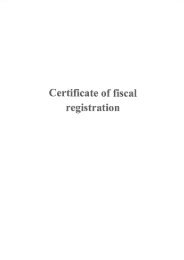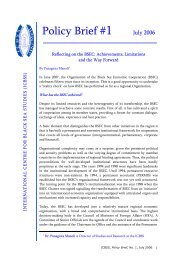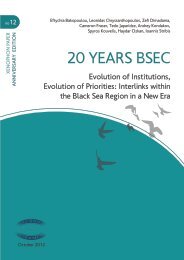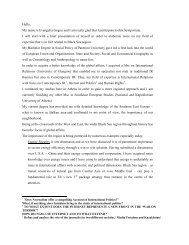Xenophon Paper 2 pdf - ICBSS
Xenophon Paper 2 pdf - ICBSS
Xenophon Paper 2 pdf - ICBSS
Create successful ePaper yourself
Turn your PDF publications into a flip-book with our unique Google optimized e-Paper software.
Low regional cooperation isolating Armenia<br />
Such realities in the region - precisely, those constants that still hamper cooperation,<br />
on the one hand, and the political agenda of Armenia’s newly formed government in<br />
1998, on the other - further influenced Armenia’s role in the BSEC and, in general, the<br />
importance Armenia placed on that organisation. This was true when, despite its slow<br />
formation process, the BSEC transformed in 1999 from a project-developing to a projectimplementing<br />
organisation. Meanwhile, the strategic importance of the region - including<br />
the Caucasus - grew for the West, and the EU’s role and involvement likewise increased.<br />
Parallel to these factors, the other issue which had an impact on Armenia’s overall<br />
involvement within the framework of the BSEC was the fact that in EU-BSEC interaction<br />
projects - proposed by the BSEC and complying with the EU’s regional interests -<br />
disproportionate importance was placed on cooperation, policy fields, and sectoral<br />
objectives stipulated by the fundamental documents in which synergy was to be attained<br />
with the EU. 7 Those spheres that were of vital importance for European expansion, those<br />
in which it had carried out numerous projects since the early 1990s, were specifically<br />
emphasised. These spheres included the development of infrastructure (including<br />
transport, energy, and telecommunications), commercial and economic activities (including<br />
cross-border cooperation and, especially, trade facilitation and the creation of favourable<br />
conditions for investments, environmental protection and sustainable development),<br />
cooperation in combating organised crime and providing emergency assistance, in<br />
institutional and social sectors, and in the domain of science and technology. While the<br />
BSEC sought synergy with the EU in the aforesaid domains, it unexpectedly experienced<br />
a hierarchy of sectoral objectives which in practice excluded Armenia.<br />
In the sphere of transport, the EU developed and supported a number of multilateral<br />
infrastructure programs for a wider Eurasia that centred on the Black Sea. As a<br />
consequence of the unresolved conflict with Azerbaijan, Armenia lost the chance to<br />
become a part of the Transport Corridor Europe-Caucasus-Asia (TRACECA). The project<br />
was launched in 1993 to connect the eight former Soviet republics. Across and around<br />
the Black Sea, the EU pursued the objective of developing transport alternatives between<br />
the East and the West, seeking out international investments to that end. It is worth<br />
mentioning that regional transport routes and infrastructure became an increased area<br />
of focus for the EU in 1997 when, following the European Conference of Transport<br />
Ministers, the Black Sea region was selected as one of four Pan-European Transport<br />
Areas. In the meantime, Armenia - as the Armenia-Georgia link - joined TRACECA.<br />
7 BSEC (2007), ‘BSEC-EU Interaction: The BSEC Approach’, Istanbul, 17 January.<br />
18 UNFOLDING THE BLACK SEA ECONOMIC COOPERATION VIEWS FROM THE REGION









